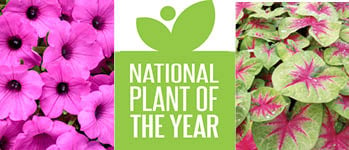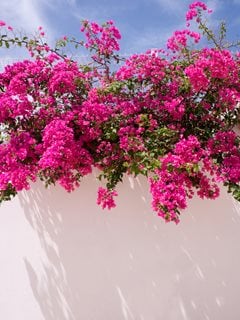HOW TO GROW BEAUTIFUL BOUGAINVILLEA
From climber to groundcover to container plant, vibrant bougainvillea fits the billLooking for a vibrant low-maintenance ground cover? Need a bright and fast climber for a trellis or structure? Want to spice up a boring hanging basket or container? Bougainvillea is the answer!
These tropical vine-like shrubs are quite drought tolerant, love the sun, and pack a huge punch of color. They grow effortlessly in mild winter areas of California, Florida, Texas, Hawaii, and along the Gulf Coast, and can be grown in containers elsewhere. Bougainvillea plants are vigorous growers that can become overgrown if not kept in check; but they offer a dazzling color show nearly year-round in warmer climates.
Zones:
Perennial in 9-11; can be grown as an annual in colder zones, or brought indoors over winter.
Height/Spread:
Most varieties of bougainvillea grow 20 to 30 feet tall and wide with support. If grown as groundcover, they will be 1-1/2 to 2 feet tall and spread 8 to 10 feet wide. There are dwarf varieties which will generally grow to be 3-6 feet tall and wide.
Exposure:
Bougainvillea thrives in full sun. Some afternoon shade in extremely hot weather may be beneficial.
Bloom time:
In zones 9-11, bougainvillea will bloom on and off all year. In colder zones, it will go dormant when brought in for winter and will bloom mainly in summer.
Color:
The true flowers on bougainvillea are quite small, usually white, and are surrounded by colorful bracts. The bracts are the real showstoppers and come in shades of red, purple, magenta, hot pink, light pink, orange, apricot and white. The bracts, often called “false flowers,” are what attract pollinators to the true flowers hidden within their brightly colored backdrop.
When to plant:
It is best to plant your bougainvillea in spring or early summer to allow its roots to become established before cooler weather sets in.
Where to plant:
Bougainvillea should be planted on higher ground or hillsides, not in water-logged or low areas where water might collect. They will grow best when given enough space to spread out, and should be planted in an area that will allow them a minimum of 5-6 hours of sunlight every day. Without enough sun, bract formation and flowering will be diminished. Some afternoon shade can be helpful in very hot weather.
Soil:
Well-drained acidic soil is best for bougainvillea. If soil is too alkaline, chlorosis (pale leaves) can occur.
How to plant:
Bougainvillea shrubs have delicate, fibrous root systems, so be careful not to damage the roots when planting. Do not tease or loosen the roots as you would with other plants. Dig the planting hole wide enough so that the roots aren’t crowded and can establish easily.
Pruning:
Pruning your bougainvillea back after blooming will keep it in shape and stimulate more flowering. Bougainvillea vines show their color on new growth, and frequent pinching will not only encourage fuller growth, but also more color. Remove dead branches in spring to keep your bougainvillea healthy. Gloves and heavy sleeves are necessities when pruning bougainvillea, as most varieties have numerous thorns. Some gardeners also experience skin irritation from the foliage.
Amendments & Fertilizer:
Bougainvillea are heavy feeders and prefer small amounts of nutrients available constantly, making a slow-release fertilizer a good choice. They should be fed regularly during their flowering season.
Watering:
Water your bougainvillea with a good soaking and then let it dry out. If they are left with wet feet, it may cause their bracts and foliage to drop. Frequent, short watering can result in a shallow and weak root system. The amount and frequency of watering should be adjusted for your climate. R&G Bougainvillea gives this handy guideline for watering: “Few leaves, but some weak bracts—not enough water. Lots of green leaves, but little color—too much water. A combination of healthy leaves and bracts—just right.”
Diseases and Pests:
Although generally quite disease resistant, bougainvillea plants may be troubled by aphids, leafminers, scale, snails & slugs, spider mites and whitefly. The best way to keep your bougainvillea healthy is to keep the foliage and area around the plant dry and allow good air flow. Promptly remove any damaged, dead or infected branches and foliage.
Training:
Bougainvillea won’t naturally attach itself and may need help climbing. Use soft straps to tie and train bougainvillea to its supporting structure. The thorns on some types are hook-shaped and will assist in securing the plant to chain link or other fencing or structures.
BOUGAINVILLEA IN THE GARDEN
- Use bougainvillea as a vibrant, colorful groundcover on hillsides.
- Train on trellises next to buildings to serve as a wall covering.
- Bougainvillea can be pruned and trained to grow in containers. For zones lower than 9, move them indoors to a garage or greenhouse over winter. Plants will go dormant in colder weather and should be watered sparingly.
- Bougainvillea can be grown as bonsai or in hanging baskets. Try dwarf varieties, B. glabra, or the Bambino family for smaller more compact plants. Tip: Hanging baskets dry out quickly and should be watered (and fertilized) often.
- Bougainvillea’s thorny nature can prove useful if grown as a security hedge.
- Keep a close eye when growing next to buildings, as it may grow into cracks or under roofing and become destructive.
8 BOUGAINVILLEA PLANTS TO GROW
RELATED:
Flowering Vines
Tropical Gardens
Ground Cover Plants for Shade or Sun













